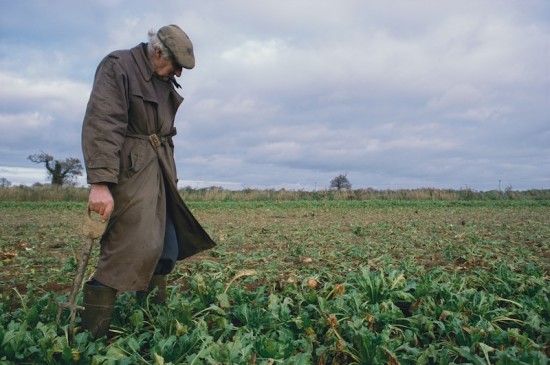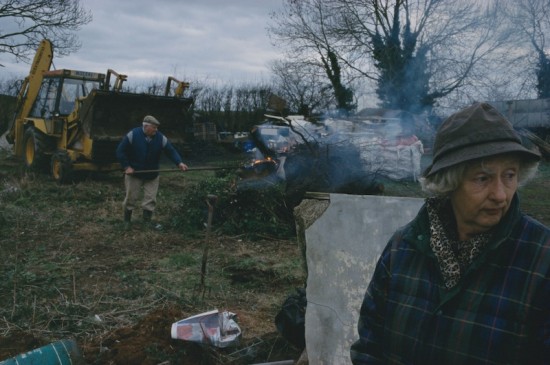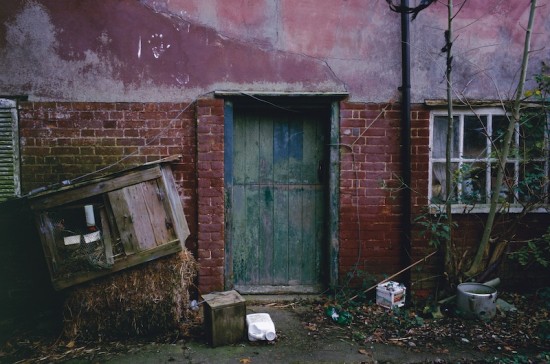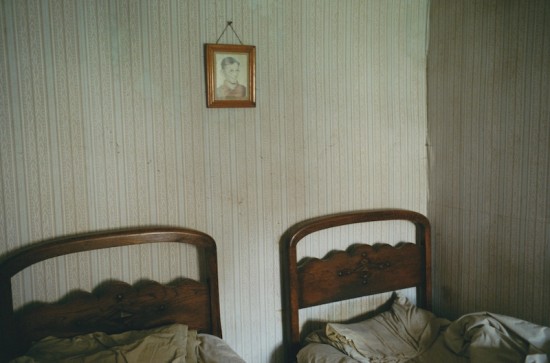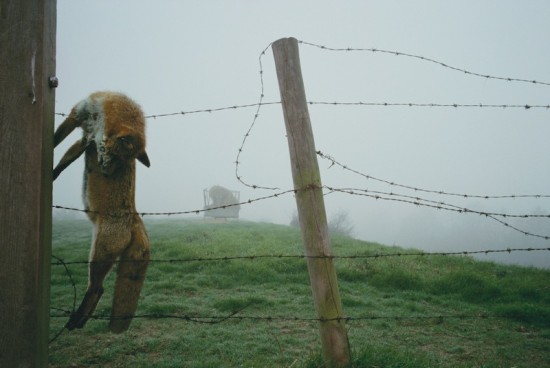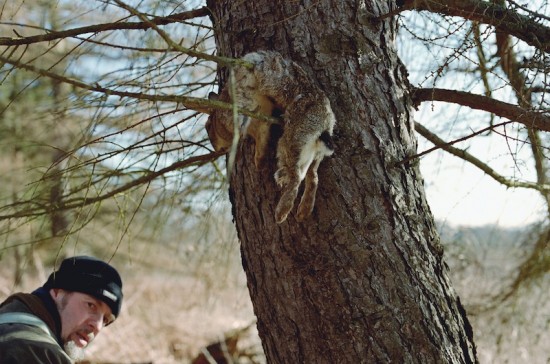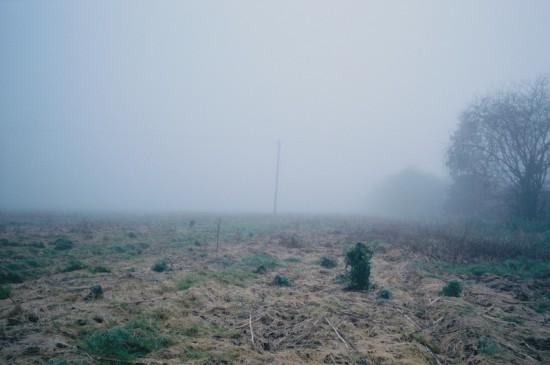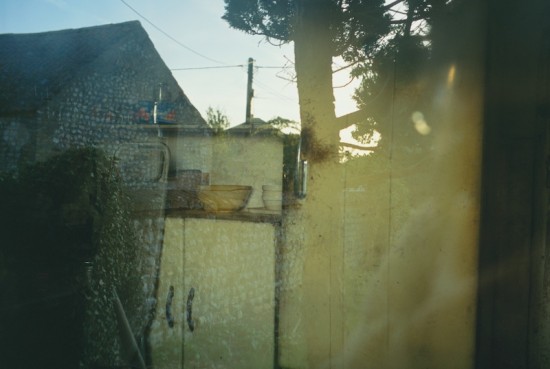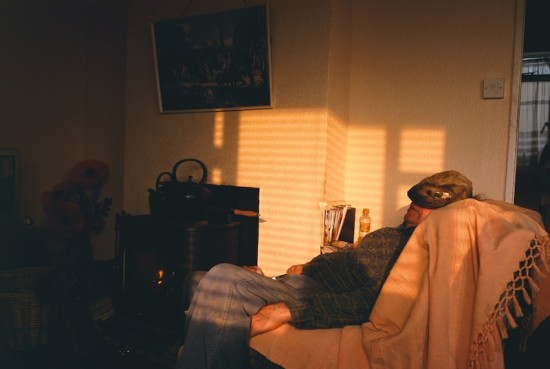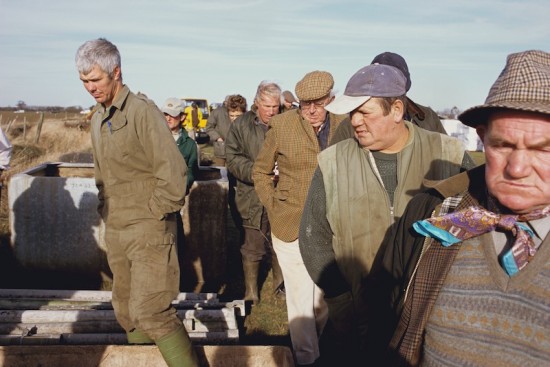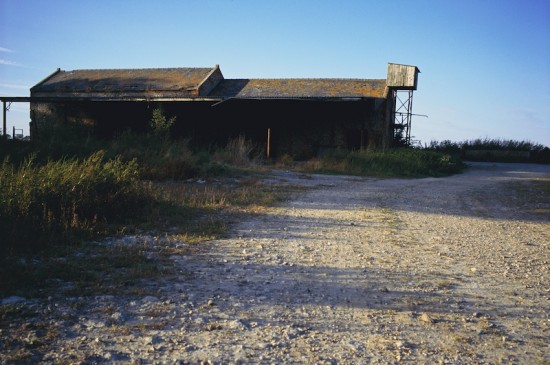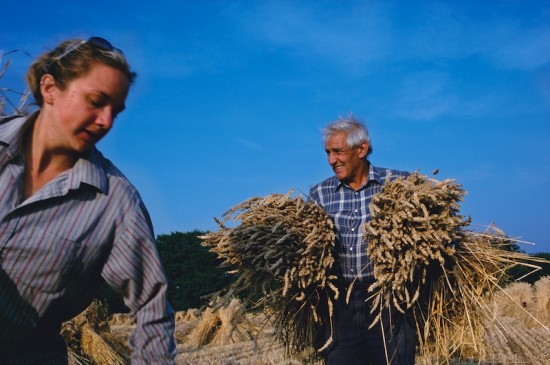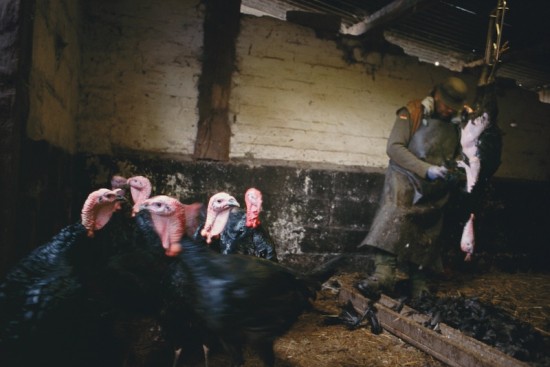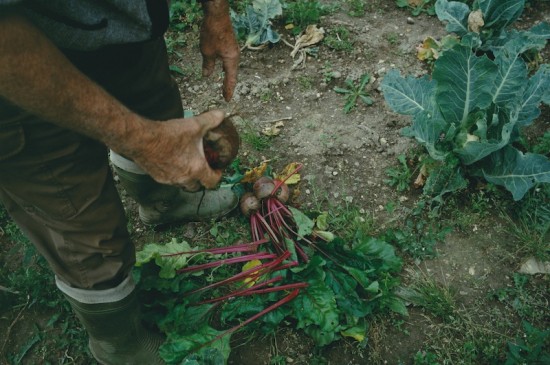Click on the image to view a slideshow.
An interview with the photographer, Justin Partyka, can be read beneath the images.
Interview with Justin Partyka, photographer of The East Anglians. 20 September 2009, High Oak, near Wymondham, Norfolk, UK.
An audio extract from this interview can be heard here.
JONATHAN WATTS: I’m sitting in a churchyard in the parish of High Oak with the Norfolk born photographer Justin Partyka, whose first major exhibition opens on the 29th September at the Sainsbury Centre for Visual Art in Norwich, and runs through October and November, finishing on the 13th December 2009. The exhibition is entitled The East Anglians. Justin…
JUSTIN PARTYKA: Jonathan…
JW: Could you give a bit of background on The East Anglians: when the project began, what the impetus for the project was, how it has led up to this major exhibition?
JP: Well, the project began in 2001 and I’ve been working on it for almost nine years now. And at this point I still feel it is perhaps not quite finished. Until a major book of the work is published I’ll always feel the work is ongoing. It tells the story of what is left of the agrarian culture of East Anglia so, these are the small time farmers, reed cutters and rabbit catchers and the landscape that these people live and work on.
JW: These people that work on the land you’ve mentioned – obviously there are large scale farms across East Anglia – were these people hard to find?
JP: Well, if you poke around enough, you’ll find them. I think it is very easy to drive across Norfolk and Suffolk and miss these people and their world because they’re small in scale. The farms are small. You drive across the region today and it is mainly these big fields and these big tractors and you go past what is left of these family farms and you don’t really think about them. So they are there and I think perhaps this project has only scraped the surface of what is there. Still today I drive around and see places that probably have potential that I haven’t explored. So as this project gets major publicity now perhaps other people might even approach me and reveal their own farms to me.
JW: We’ve been to farm sales together and really they’re places that you can meet these people. So you hope the publicity from the exhibition might encourage people to approach you who perhaps can identify with those in the photographs?
JP: Well that would be nice. It isn’t something I’ve emphasised in any way, but it is perhaps something I should mention in some of the local press we get here in Norfolk. Obviously you can’t discover every single small time farm in East Anglia. It would be nice but it is such an extensive region. I was just saying as we came to High Oak here, you could go out in Norfolk everyday and find somewhere new.
JW: Why do you think it is important to document these families and these farms?
JP: Well, they’re living a forgotten way of life. And they’re also living a way of life that has a lineage back to the first farmers of this region. The idea of working on the land in a small scale and their attitudes towards the work are very much linked to farming of the past.
JW: It is interesting that throughout the marketing of the exhibition it has sometimes related the work to much larger issues about the environment and “green living.” Do you think these people have a model “green” way of living?
JP: No.
JW: Well, it has become something that those in marketing can latch onto.
JP: Yeah.
JW: And how do you feel about that? Is that part of why you want to present these people?
JP: No not really. If all the large-scale commercial farms in East Anglia, or throughout the world, were suddenly forced to break up the land into smallholdings, and everything was worked on a much smaller scale, obviously that would be beneficial to the environment.
JW: In what kind of ways?
JP: If more work was done by hand you haven’t got to worry about the supply of fuel for massive tractors and combines. They go through fuel like you wouldn’t believe.
JW: It is an oil dependant industry.
JP: Well, yes, farming very much is. Not just for the production of the crops: if you look at a field of wheat and think about what it takes for that wheat to end up as a loaf of bread in the supermarket. If you worked out the miles traveled and the fuel involved, it would be quite amazing. It is not something I am really knowledgeable about but there are various books written on the idea of food miles and to keep food miles on a local level is obviously beneficial to all concerned. But it is not something that these people I’ve photographed have consciously thought about. It is just common sense to work the land in a traditional way and keep everything local. Really this should be the future. I’m sure it is something that will never happen but you can see that the ideal way of living would be to give up machinery and go back to working the land with animals.
JW: Could you imagine a situation where that would happen?
JP: Who knows. Things change. I’m 36 and even in my lifetime things have changed dramatically. They talk about the oil running out and vehicles costing too much to run. You can never say never, you just don’t know.
JW: So lets talk about the photographs themselves. How many photographs are there in the exhibition at the Sainsbury Centre?
JP: There are fifty-seven. We just hung the show Thursday and Friday. We had fifty-eight photographs, we ended up taking one out. There are fifty-seven, all in colour.
JW: Various sizes?
JP: Yeah, there are various sizes. It is something I’d like people to discover when they see the show so I don’t want to say too much.
JW: There is a mix of unpeopled and peopled landscapes, interiors, people working the land – is there some kind of logic? Have you ordered them according to some kind of logic?
JP: In parts there is. But for me – how I see the work – it is my journey through this agrarian world. I feel the work weaves in and out of interiors, exteriors and farm sales. When we were sequencing the show there were certain things that the curators thought made sense to keep together and some of this I perhaps wouldn’t have done. When you’re working with curators they can see things different to you. You’ve spent nearly ten years on a project; obviously the work is very intimtite to you. You’ve spent hundreds, if not thousands, of hours with the images, and you see them in a very personal way and feel they should be presented in that way. And somebody who has spent the best part of a year thinking about them sees it differently. Also they have to negotiate how they present the work to their audience. You have to have a bit of give and take.
JW: We’ve discussed a lot about the different ways people see the work, obviously you have a lot invested in it. Sometimes people come along and want to crop an image, and that is something you don’t do, crop images. You seem to try and contain control over the process.
JP: You have to keep control Johnny. If you’re not prepared to keep control and fight for your work, then I can’t see the point of doing it really. Whatever it is: photography, writing, or whatever you are doing, you have to be prepared to fight for it. When people use the work in ways that you feel are inappropriate, it is important that artists and writers speak up and make their opinions known. It is very easy for people who are using your work in various ways to take it for granted that they can edit and cut things in certain ways that affect the context of the work. But at the same time though on the curatorial side there has to be some give and take and in the end I agreed that a couple of images could be cropped for publicity literature. I was a bit reluctant, but the Sainsbury Centre presented a good case in defense and I gave in.
JW: You didn’t have a formal training in photography. But you studied something not completely unrelated. If you could just explain how you came to photography and how you think your background has influenced what you do now?
JP: Well I wasn’t even living in Norfolk when I began this project. I was living in Newfoundland, Canada where I had gone to study folklore to do an MA.
JW: You went over on a scholarship?
JP: Yes. I did my BA degree in England at Brunel University, in American Studies. I’ve had a long interest, for many years now, in American culture, especially music and, even more specifically, folk music of the south and American literature so American studies seemed a very natural thing for me to do a degree in. It gave me an opportunity and excuse to read about things I was already interested in. It was great! When I finished that I felt I wanted to continue my education so I got in touch with one of the professors in the folklore department in Newfoundland at Memorial University, Neil V Rosenberg, who is probably the most prominent bluegrass music scholar. I had written my BA Honors thesis on bluegrass and had been in touch with Neil with various research ideas and he suggested I apply to the folklore department to go and study with him – which is what I did. I received a scholarship and went off to Canada. The summer before I left I was over inWashington DC working for the Smithsonian at the folklife festival there and in the Folkways Records archive, which was a great experience. I did that, came back to England for a few weeks, and then moved out to Canada. Studying folklore really combined my interest in American culture, although I was going to Canada most of the key folklore scholarship comes out of America so you’re still very connected to America. But also it gave me the opportunity to explore the ideas of traditional culture which is something that I think my interest in comes from growing up in Norfolk.
JW: The thing that I think is very interesting about folklore is that there is a range of mediums that are used in the field. Not just photography, but also sound recording, and not just sound recording but film too. The East Anglians is not just photographs you also have an extensive archive of sound recordings and video that you’ve collected.
JP: It’s funny, when I went to study folklore, sound recording was my main interest and the medium I was interested in working with within the field. I don’t know how it happened but I quickly saw the value of photography and it became to me the way to communicate with the world. And I think simply a way to look at it is that the music I had this desire to record didn’t exist anymore. I had to rethink, perhaps unconsciously, how I was going to document traditional culture. If the musicians I wanted to record didn’t exist, photography gave me a way to document things that had the aesthetic visually, instead of aurally, but that had this aesthetic I was looking to embrace.
JW: That visual aesthetic, did you find it in Canada? When did you realize East Anglia was where that aesthetic might exist?
JP: Well the irony is that when I left Canada I thought I’d never return to Norfolk. Although I knew the value culturally of the place, I think to me I had exhausted what I could get from Norfolk as a person. They always say the grass is never greener and when you’re young you think it is and you can’t wait to jump over the hedge. I went to Newfoundland, I had spent a bit of time there, and a couple of professors – there is an interesting mix of Canadian, English and American professors in the department – and a couple of the professors who are English and had been over there a long while now, introduced me to two key figures. One of those was George Ewart Evans and the other was Peter Henry Emerson: Emerson who photographed in East Anglia in the 1880s and Evans who, in the 1950s and early 60s, did extensive oral history work in Suffolk and parts of Norfolk.
JW: The other pivotal figure was John Cohen.
JP: Yes.
JW: Actually it must have been interesting for you to come across Cohen because he is somebody who had used photography, sound and film. And incidentally had been to Norfolk and made a film of the traditional ballad singer Walter Pardon in Knapton.
JP: Well John Cohen actually is the reason I went to study folklore – his work Mountain Music of Kentucky which came out in 1959 as an LP on Folkways Records. What is important about this work is that it is not just a music album of field recording he’s made of people singing and playing music in rural Kentucky, it has extensive written notes that come with it which are basically an ethnography of the place and the culture and the musical traditions that he encountered. He also included an album of photographs and he presents them as a photo album. Which I think had never been done. Not just the odd picture but he presents them as a work of art. And it really showed me how all these mediums that could be used to document a place could be tied together. I think really I wanted to be able to record the kind of musicians that Cohen had.
JW: Did you think they might be in East Anglia?
JP: Well no. I knew they weren’t in Norfolk but I think what I did know was the kind of things that Cohen did photograph, the world around these musicians, I knew there was a similar world in Norfolk, and I think that is what I decided to seek out to discover and tell the story of this world through photography, and my discovery of this world.
JW: This is something I am interested in with your work: this balance between personal expression and the documentary or ethnographic value of the photographs. From an ethnographic background – which might be considered a science – that doesn’t sit very easily with self expression. So there is a tension between those two elements that I find interesting in your work
JP: Well, the reason I eventually left academia was because of that tension. There are very regimented ways that academic work and writing is conducted and how it is presented and to quite a large extent the idea of creativity and any kind of artistic expression especially, is curtailed. It is seen as going against this idea of objectivity. In the end it seemed the way I wanted to undertake my work and present it didn’t fit with the way academia expected you to. It was a fight I felt I didn’t want to waste energy on. I had started a PhD in Newfoundland and finished a well-received MA thesis on a Norfolk rabbit catcher, which is how The East Anglians started from my work with him. I used photography extensively in the thesis and I realized after I had finished it I could take photography even further but it was going to create problems. I’d started the PhD, done the coursework, passed the comprehensive exams. When it came to writing proposals for a PhD dissertation, I worked on a couple of different ones and they weren’t received very well and I was struggling with what I could do. I couldn’t come up with something that would satisfy me and satisfy them. After finishing the thesis on the rabbit catcher I took a trip back to Norfolk just to see and have a look around for things that might interest me. I came back for six weeks and explored and met a few farmers and I really thought, well, there is potential to do something here.
JW: The irony is that if you’d stayed in academia in Canada and continued on the theme of the rabbit catcher you would be a specialist now in rural life studies of Norfolk.
JP: I guess if I had done my PhD on an aspect of Norfolk rural life, and I did explore different avenues. I first thought about trying to do my own work, or something on the work of Emerson or Evans, but that would have been about examining somebody else’s work done in the field instead of my own.
JW: You would have been an expert over 1,000 miles away from the place.
JP: Obviously that happens. A PhD dissertation is a specialist document and when you’ve written one you become an expert in the minute field you’ve decided to write 1,000 pages on. At the same time it ends going to such a small audience: a PhD dissertation is read by the supervisors, the examiners and often not many other people. I knew that how much energy both mentally and physically it was going to take to write one, I thought is it really worth it when I could be putting that energy into The East Anglians.
JW: Do you presume to give the farmers present in The East Anglians a voice?
JP: I think the photographs, if anything, are my own voice. I think they’re more my voice than the farmers’. I think if you gave the farmers a camera and asked them to photograph their world it would come out very different. So it is very much a subjective body of work. But at the same time I’m obviously, in a minor way, stating the case that there is this agrarian way of life that still exists that is largely invisible. So I suppose in a way you could say I’m giving that agrarian culture a little bit of a soapbox to stand on but obviously it is mediated through me and how I’ve portrayed it. Because the work is showing people that exist as a reality it is easy for people to latch on to the work as a document but it is more complicated than that. There are a lot more layers going on. I think it is problematic just to say the work documents this way of life because it is about my journey though this world and it is world that, as Thomas Hardy created Wessex or William Faulkner created Yoknapatawpha county in Mississippi, I think the world of The East Anglians is a world I’ve created myself. You couldn’t park up your car in Norfolk, step out and enter into it because it is very much a world that is fragmented that I’ve brought together.
JW: This is very interesting. If I were to describe your photos – your aesthetic –
most of them are taken at dusk, they have a limited palette as a result of low light levels, they certainly project a strong sense of melancholy through the use of light. Is it a melancholy world you’re projecting?
JP: To me it is. People talk about Norfolk as a place with big skies but to me Norfolk is a melancholy place. It is the idea of pulling away the surface of what people think is there and getting to the heart of the place. I think you really get to the heart of these places – when they reveal their true character – in the middle of the winter. When that bleakness comes out. That’s when I feel most at home in the region. As a photographer this is what excites me.
JW: Are you trying to challenge certain clichés about what the East Anglian region is like?
JP: Not consciously, but perhaps the work tries to challenge the romanticism of the place. If you go to north Norfolk and the small villages, every place has a gallery featuring paintings of the place, and I think I’ve tried to show a different side to this place.
JW: It is an East Anglia without cars, and Tescos and B&Qs and industrial estates.
JP: Well, yes, it is this idea of trying to grab on to the place’s timelessness I think. If you have a big map with all these thing on there like a Lego world, like cars, Tescos and B&Qs and industrial estates, modern housing estates and you swipe these away off the map. What is left are all the things that have been here that have a direct lineage going back hundreds of years, they’re so rooted in the ground that you can’t wipe them away.
JW: And they still influence the culture?
JP: No. I think the culture has become the dominant Tesco. When I talk about the world that people forget in The East Anglians it is so far removed from this that for most people it doesn’t exist. And I think to me the things that would be left on the map, they’re the true character of this region – they’re what shape the region.
JW: Are you concerned by these “hyper” ways of living – of modern life?
JP: Well, yes and no. Obviously I’m very much a part of modern life. When I step into the world of The East Anglians I switch off from it, but after a day’s photography I enter back into my own world which is the modern life. So I very much have a foot in both places. I think really, I think for me to live in the world of The East Anglians, is not a world in which I could live. The things I am dependent on – the technology and things you take for granted just aren’t there in that world. I’d be a hypocrite to say I’m trying to protest modern life – I’m not. I think in an ideal world we could all live like The East Anglians – but it isn’t ideal.
JW: Amongst these farmers there is a tremendous work ethic. There is a sense that work is virtuous. How do they view your work as an artist?
JP: What I do they don’t consider as work. For them the idea of work is physical hard labour – working on the land. For me I feel my work perhaps is equally as hard but in a different way. I spend hours and hours photographing and the reward you reap from that is a handful of great pictures in ten years. If you think of the hundreds of hours you spent and the thousand of pictures you’ve taken. If you equate that to growing crops, you’re not getting a very good harvest! At the same time you’re growing a specialty crop. You’re not going to get fields worth. They struggle to comprehend what I’m doing as work. But all they know is how to work, and all I really know is how to go out and photograph.
JW: Over the time that you’ve been photographing these small farms across East Anglia you’ve built up some very strong relationships with certain farmers. Can you talk a bit about that because I know by some you’re seen as just being part of the furniture.
JP: Well, yes I guess so. To try and simplify it a little bit, there are two ways that I’ve worked on this project. One approach is that you end up going somewhere for a few hours. You end up at a farm, or you go to a farm sale and work intensively for a few hours and you are gone again. And the other side of it is that I have developed a network of farmers that I visit on a regular basis. Both approaches have been important and ended up with good photographs, and they both have their value. The idea of building up a network, you get to visit regularly and explore really intimately the way of life these people lead, and you get to befriend them.
JW: Whilst you do photograph small farms and a certain way of farming, I think it is important to emphasise that it isn’t uniform and within that there is a diversity to the approaches and the relationship to the land. Is that right to say?
JP: I think the emphasis of the work is to show the intense connection these people have to the landscape. They are not just people who work on the land, they belong on the land. They are as part of the landscape as a tree or a bush, or the crops that they grow. And that is uniform throughout hopefully. I hope that if people go to the exhibition they are going to see that. There is no incongruity: if you see somebody standing working in a field they are so naturally part of that landscape. And I think at the same time with the buildings that I’ve photographed, the sheds, barns, and farm houses, to me it is like the landscape has enveloped them and they belong there. And the interiors of the buildings to me they are landscapes. And the feel of the landscape outside is very much reflected inside too.
JW: I think something you need to make clear – something that I’d like to clarify – is that you are not saying that these are natural landscapes. It is not about finding a kind of unmediated nature.
JP: No. It is a rural landscape, and I suppose on the next level it is an agricultural landscape. It is a landscape that has been shaped by man, but it is a landscape that shapes man equally. It is this idea of an equal intimate relationship to the land. These are not the unknown wildernesses of Norfolk. That is not what the work is about. But obviously in these landscapes nature is there. But coming back to the idea of creating this world, it is an enclosed world.
JW: So it is possible to examine these people in quite defined terms and how the landscape effects them?
JP: Yes, I guess that is what I have tried to do. It would be very easy for somebody to come along and criticise it and question it. But I think you have to do your own work how you see it. You can’t start off thinking, “what will be the criticisms of this work?”
JW: I think also you investigate that idea, and that’s the value of it. This could be seen as a body of work that investigates the idea of an indigenous people and how they are shaped by an environment.
JP: Well things outside of that world are entering into it all the time, but I haven’t showed that because I think then you present the work in a very different way. It is just about telling a story, as a photographer you are a storyteller.
JW: Any wise words to aspiring young photographers?
JP: I think you have got to find the story you want to tell. Find the work you want to do and if it takes a lifetime to do that you’ve got to be prepared to do it. I’ve met too many young photographers who are fleeting between various things and don’t really know what work they want to do, and at some point you’ve go to take the leap and say, “I’m going to do this work.” It might not even come to anything after ten years, but you’ve got to take that chance and build up a body of work and have faith in it and know it is important and put the work in, and hopefully everything else will come along. But if you jump between a different project every year, you’re not spending enough time on anything. It takes a long time. Photographers who in a few weeks think they have done a project are only just getting started. I think that would be the crucial advice. You’ve go to have something to say, find the story you want to tell, and work. Forget everything else and work.
All content: Copyright © 2009 Justin Partyka and Jonathan Watts. Not to be used without permission.
Related links:
http://sounding-east.blogspot.com/
Justin Partyka is a British photographer and writer currently based in the county of Norfolk. He trained as a folklorist at Memorial University, Newfoundland, Canada, before moving back to the UK to work on The East Anglians. Partyka has exhibited at Tate Britain, Belfast Exposed, the Jerwood Space, and various galleries in East Anglia. His work has been published in Granta, the Guardian Weekend, Source, the Drawbridge, and on burnmagazine.org.
Jonathan Watts is an artist and writer based in Great Yarmouth, Norfolk. In October he will be reader in residence as part of the Nightjar Festival in the city of Cambridge.
